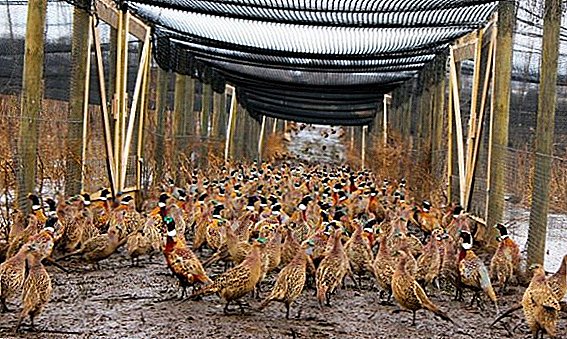 Properly planted and grown lawn will serve you for a long time. But, wanting to get lawn grass on their plot, many, especially beginning gardeners, face many questions, for example: “How to choose and calculate seeds?”, “When is it best to sow a lawn - in the fall or spring?”, “What should be the layout? "," How to prepare the soil? "," How to care for the lawn? ". We will try to answer these and some more questions in the article.
Properly planted and grown lawn will serve you for a long time. But, wanting to get lawn grass on their plot, many, especially beginning gardeners, face many questions, for example: “How to choose and calculate seeds?”, “When is it best to sow a lawn - in the fall or spring?”, “What should be the layout? "," How to prepare the soil? "," How to care for the lawn? ". We will try to answer these and some more questions in the article.
Did you know? The lawn is divided into decorative lawn and lawn with a special purpose. Of them can be distinguished: sports, ground, meadow, Moorish, grass.
How to choose the seeds of lawn grass
 One of the most important factors for creating the right lawn with your own hands is the correct choice of seed. First of all, it is necessary to consider the intended purpose of the lawn, because for each species different herbs or grass mixtures are needed. Although the main components of almost all such mixtures are unchanged (ryegrass, fescue, bluegrass and a few others), they differ in combination and ratio of varieties.
One of the most important factors for creating the right lawn with your own hands is the correct choice of seed. First of all, it is necessary to consider the intended purpose of the lawn, because for each species different herbs or grass mixtures are needed. Although the main components of almost all such mixtures are unchanged (ryegrass, fescue, bluegrass and a few others), they differ in combination and ratio of varieties.
The choice will also determine when it is possible to sow lawn grass, because different species have different frost resistance and growth rates (bluegrass, for example, grows slowly in the first years), what will be the height of the planned lawn at your cottage (fescue well tolerates a short haircut) the quality of turf (rye grass is distinguished by a good turf), etc.
Different grass mixtures require different soils, may differ in seeding rate and other characteristics. All useful information you should look for on the package and be sure to carefully read it before purchasing.
Ask the seller: whether this or that mixture is suitable for your climate, when it is preferable to plant lawn grass - in spring or autumn. When choosing, consider the features of your site (what is the illumination, is there any ground water, etc.).
Important! Pay attention to the presence of state or international certificates confirming the quality of the goods.
Lawn layout
 You can plan and plant a lawn in almost every corner of your site. And the shadow, and the sun, and the horizontal surface, and the slopes, and sandy, and clay soils. The difference in each case will be only the amount of material and physical effort required to plant and grow a really beautiful and green lawn. It is better if it is a sunny place where thawed and rainwater do not stagnate.
You can plan and plant a lawn in almost every corner of your site. And the shadow, and the sun, and the horizontal surface, and the slopes, and sandy, and clay soils. The difference in each case will be only the amount of material and physical effort required to plant and grow a really beautiful and green lawn. It is better if it is a sunny place where thawed and rainwater do not stagnate.
Before you start sowing, it is better to think over and even sketch the scheme of the future lawn. Decide whether you will leave trees, make flower beds or grow individual flowers. It is necessary to pre-plan the places where the elements of landscape design will be placed, since then there may be difficulties with cutting the grown lawn.
If you use a lawnmower, for convenience, when you sow lawn grass, leave a distance of about 1 meter between it and curbs, walls or fences. Also, do not plant a lawn under a single tree or shrub. It is better to use decorative chips for tree trunks or decorate them with ground cover plants.
How to calculate the number of seeds for planting
 To calculate the seeding of grass mixture for each individual type of grass that is included in its composition, use the following formula, and the results are summarized. The seeding rate (kg / ha) is multiplied by the percentage of this species in the mixture and divided by the actual suitability of the seed. Practice shows that in order to sow lawn grass with your own hands, it is necessary to increase the consumption of seeds in two or even three times.
To calculate the seeding of grass mixture for each individual type of grass that is included in its composition, use the following formula, and the results are summarized. The seeding rate (kg / ha) is multiplied by the percentage of this species in the mixture and divided by the actual suitability of the seed. Practice shows that in order to sow lawn grass with your own hands, it is necessary to increase the consumption of seeds in two or even three times.
If you decide to sow only one type of grass, then simply follow the seeding rate of the selected crop. On average, you need to take 30 -50 g of seed per 1 m².
Important! If you are unable to correctly calculate the required number of seeds, then you can try to find out the germination density of the variety at home. Select ~ 100 seeds and plant them at home, and after a week (10 days) check the results.
When to plant lawn grass - in the fall or spring
Answering the question "When to plant lawn grass in spring or autumn?", It should be noted that there is no consensus on the most appropriate time. Sowing is possible in any period from spring until frost. Some gardeners claim that the grass planted in May grows better, others say that it will grow greener in summer, and still others believe that the best time to plant is autumn.
 Just do not go to extremes, do not rush (planting a lawn in the spring does not occur before the earth warms up) and do not wait for the snow. When planting in autumn, time should be correctly calculated. Two options are considered optimal.
Just do not go to extremes, do not rush (planting a lawn in the spring does not occur before the earth warms up) and do not wait for the snow. When planting in autumn, time should be correctly calculated. Two options are considered optimal.
Either sow the lawn at the very beginning of autumn (then the grass will have time to climb before the frost, and you can process it for wintering), or wait until the ground freezes, but before snow (in winter the seed will undergo stratification, will become resistant to diseases and will germinate in the spring).
When people sow lawn grass in spring, they must take into account the need for regular watering and weed removal, which is more difficult than the option of planting at the end of summer. Many experienced specialists are inclined to consider this period as optimal, since the ground is well heated and wetted, the weeds are much shorter than in the spring, and the lawn has time to germinate well before the frosts begin.
As we see, neither the season, nor the temperature at which you will sow the grass, has any special meaning; each option has its own advantages and disadvantages.
Did you know? The most famous and expensive lawn is the one located near the Canberra government building (Australia). Every year hundreds of thousands of dollars are spent on its maintenance. Several dozen workers daily regulate its irrigation, taking into account temperature, dry air and other criteria.
How to prepare the ground for planting lawn grass
 Regardless of the time of sowing lawn grass, it is necessary to prepare the soil for it. This is one of the most important stages of laying a lawn. Remove from the site all the garbage, stones, branches, uproot stumps. Dig the soil to a depth of about 25 cm. Add sand to heavy soil, and sand to clayey soil. With low fertility is to take the compost. Also get rid of weeds.
Regardless of the time of sowing lawn grass, it is necessary to prepare the soil for it. This is one of the most important stages of laying a lawn. Remove from the site all the garbage, stones, branches, uproot stumps. Dig the soil to a depth of about 25 cm. Add sand to heavy soil, and sand to clayey soil. With low fertility is to take the compost. Also get rid of weeds.
A week before sowing, use complex mineral fertilizer and evenly distribute it on the site using a rake. Smooth the area, break large earthen lumps. Use the shovel and rake. Once again level the soil with a large board. This will help cut the tubercles and fall asleep hollows.
Just before sowing, tamp the soil with a hand roller or board (in this case, you need to shift it across the section and move from one end to the other).
Important! Whenever you decide to equip a lawn - in spring, summer or autumn - be sure to note that the site can be tamped only in dry weather, with dry soil. And only 2-3 days before sowing lawn grass, the chosen place should be watered.
How to sow lawn: the process of planting lawn grass
 Weather for sowing should be dry, windless. To distribute the seeds evenly, you should divide the plot into square meters and sow as many seeds as recommended for each herb or grass mixture in each.
Weather for sowing should be dry, windless. To distribute the seeds evenly, you should divide the plot into square meters and sow as many seeds as recommended for each herb or grass mixture in each.
Seeds are embedded in the soil to a depth of 1-1.5 cm, first they are scattered along, and then across. If possible, use a manual planter, it is more convenient, but you will be able to plant the lawn yourself by yourself. So that the seeds are not carried away by the wind, they can be powdered with a 1-centimeter layer of peat and rolled.
Lawn care in the country: how to grow a good and thick lawn
It is important to properly care for the lawn, because otherwise it will begin to grow and fade. Watering and cutting in this process play a significant role.
Features of watering the country lawn
Immediately after sowing, if the soil is dry, you should water the area, but gently, with a weak pressure, so as not to wash the seeds. During germination and the formation of turf make sure that the lawn does not dry out. Further watering should be regular, but consider the weather conditions.
 It is also necessary to water after cutting (to help him recover, to give a neat look and color saturation) and to feed (in order to transform useful substances into a soluble form assimilated by the root system of plants). Experts advise watering the lawn in the evening.
It is also necessary to water after cutting (to help him recover, to give a neat look and color saturation) and to feed (in order to transform useful substances into a soluble form assimilated by the root system of plants). Experts advise watering the lawn in the evening.
When and how to mow the lawn
Anyone who wants to plant a lawn on his plot should understand that a haircut is necessary not only to maintain its proper appearance. It is also a way to control weeds and stimulate vegetative development (it helps to form additional shoots, develop the root system, thus creating a dense turf).
Before mowing, check the lawn for foreign objects. For the first time a lawn is sheared after a month and a half after the appearance of sprouts. The height of the first haircut should be at least 6-8 cm. All subsequent ones, taking into account the type of lawn, should be 3-5 cm. In the fall and spring, add another 1 cm to this height.
Each time you cut across or diagonally to the previous one, shear no more than 3-4 cm. If the grass has grown too much over a long period of time, the cutting is done several times with an interval of a couple of days.
 The blades must be sharp, otherwise, and if you cut a wet, wet lawn, the tips will find a rusty color. You need to cut regularly, as soon as the grass has grown 1.5 cm above the desired height, which is about 1 time per week.
The blades must be sharp, otherwise, and if you cut a wet, wet lawn, the tips will find a rusty color. You need to cut regularly, as soon as the grass has grown 1.5 cm above the desired height, which is about 1 time per week.
Did you know? People with allergies are advised to get a lawn near the house. Indeed, 1 hectare of lawn grass can hold up to 60 tons of dust particles.Follow our recommendations, and all neighbors will envy the lawn on your site.












